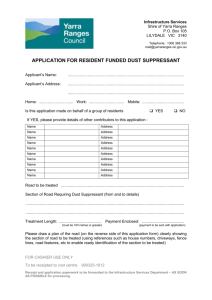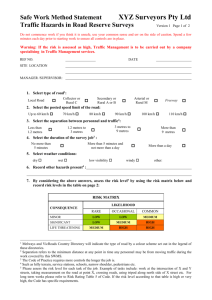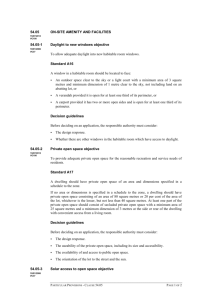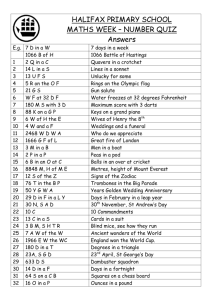Neighbourhood Residential Zone - Monash
advertisement
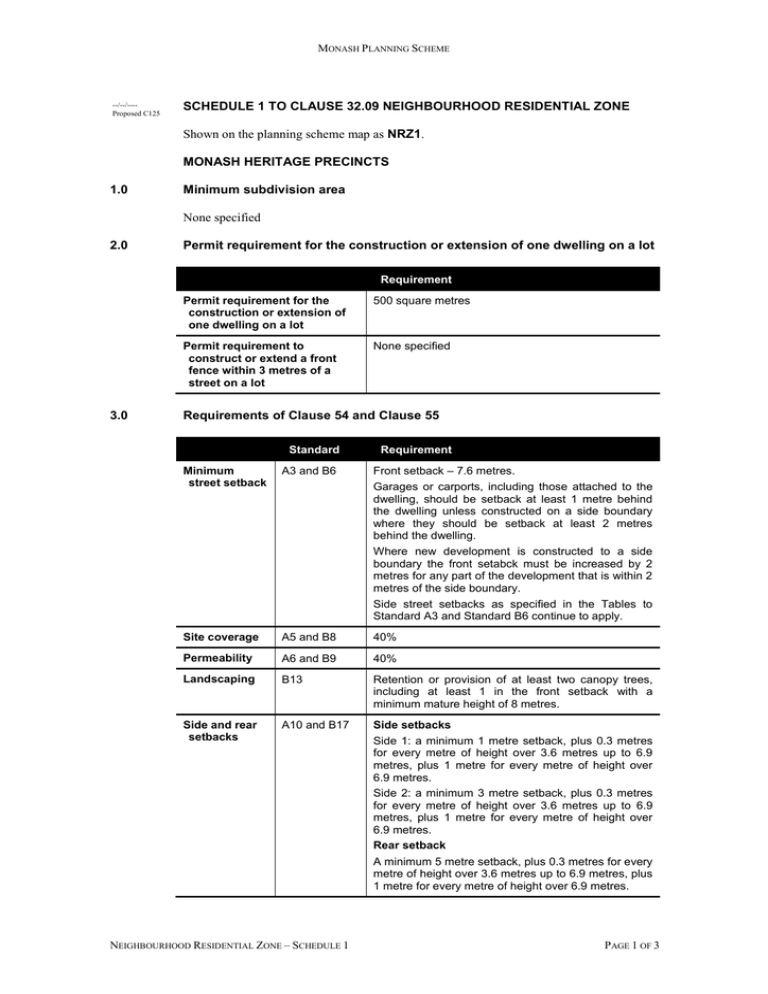
MONASH PLANNING SCHEME --/--/---Proposed C125 SCHEDULE 1 TO CLAUSE 32.09 NEIGHBOURHOOD RESIDENTIAL ZONE Shown on the planning scheme map as NRZ1. MONASH HERITAGE PRECINCTS 1.0 Minimum subdivision area None specified 2.0 Permit requirement for the construction or extension of one dwelling on a lot Requirement 3.0 Permit requirement for the construction or extension of one dwelling on a lot 500 square metres Permit requirement to construct or extend a front fence within 3 metres of a street on a lot None specified Requirements of Clause 54 and Clause 55 Standard Requirement Minimum street setback A3 and B6 Front setback – 7.6 metres. Garages or carports, including those attached to the dwelling, should be setback at least 1 metre behind the dwelling unless constructed on a side boundary where they should be setback at least 2 metres behind the dwelling. Where new development is constructed to a side boundary the front setabck must be increased by 2 metres for any part of the development that is within 2 metres of the side boundary. Side street setbacks as specified in the Tables to Standard A3 and Standard B6 continue to apply. Site coverage A5 and B8 40% Permeability A6 and B9 40% Landscaping B13 Retention or provision of at least two canopy trees, including at least 1 in the front setback with a minimum mature height of 8 metres. Side and rear setbacks A10 and B17 Side setbacks Side 1: a minimum 1 metre setback, plus 0.3 metres for every metre of height over 3.6 metres up to 6.9 metres, plus 1 metre for every metre of height over 6.9 metres. Side 2: a minimum 3 metre setback, plus 0.3 metres for every metre of height over 3.6 metres up to 6.9 metres, plus 1 metre for every metre of height over 6.9 metres. Rear setback A minimum 5 metre setback, plus 0.3 metres for every metre of height over 3.6 metres up to 6.9 metres, plus 1 metre for every metre of height over 6.9 metres. NEIGHBOURHOOD RESIDENTIAL ZONE – SCHEDULE 1 PAGE 1 OF 3 MONASH PLANNING SCHEME Standard 4.0 Requirement Walls on boundaries A11 and B18 A wall on a side boundary should not exceed 6.5 metres in length. Walls should not be constructed on rear boundaries. Private open space A17 and B28 A dwelling or residential building should have private open space consisting of an area of 75 square metres. At least one part of the private open space should consist of secluded private open space with a minimum area of 35 square metres and a minimum dimension of 5 metres at the side or rear of the dwelling with convenient access from a living room. Front fence height A20 and B32 A front fence within 3 metres of a street should not exceed 1.2 metres. Number of dwellings on a lot None specified. 5.0 Maximum building height requirement for a dwelling or residential building A building used as a dwelling or a residential building must not exceed a height of 8 metres unless the slope of the natural ground level at any cross section wider than 8 metres of the site of the building is 2.5 degrees or more, in which case the height of the building must not exceed a height of 9 metres. 6.0 Application requirements The following application requirements apply to an application for a permit under clause 32.08, in addition to those specified in clause 32.08 and elsewhere in the scheme: Plans showing existing vegetation and any trees proposed to be removed. Plans showing proposed landscaping works and plating including tree species and mature height. A schedule of materials and finishes to be used in the development. A plan identifying service areas, such as waste and recycling areas, utilities and services (including antennas, air conditioning units, fire fighting equipment and letterboxes). 7.0 Decision guidelines The following decision guidelines apply to an application for a permit under clause 32.08, in addition to those specified in clause 32.08 and elsewhere in the scheme: The preferred character statement contained in any applicable neighbourhood character study or housing study. Whether development contributes to ‘garden city’ character. Specifically, whether the proposal: Provides sufficient and well located open space, primarily unencumbered by easements, to provide for large trees to be retained or planted within front, side and rear setbacks, and secluded open space areas. Environmental weeds and artificial grass should be avoided. Provides vegetation in the front setback that softens the appearance of built form and contributes to the public realm. Sites buildings to minimise the need to remove significant trees, and protect significant trees on the site and adjoining properties. NEIGHBOURHOOD RESIDENTIAL ZONE – SCHEDULE 1 PAGE 2 OF 3 MONASH PLANNING SCHEME Minimises hard paving throughout the site by limiting driveway widths and lengths, providing landscaping on both sides of driveways, and restricting the extent of paving within open space areas. Maximises planting opportunities adjacent to the street by excluding hard paving such as car parking, turning circles and driveways, and minimising basement car parking, within the front setback. How vehicle crossovers are located and minimised in number to prevent traffic disruption, and preserve nature strips and street trees. Whether new buildings include significant breaks and recesses that reflect the prevailing widths of contributory buildings to avoid large block like structures dominating the streetscape. Whether the development uses robust and low maintenance materials and finishes that complement the streetscape, can withstand weathering and create minimal adverse impacts (for instance, safe walking surfaces and limited reflective materials). How the development minimises the visual and amenity impact of utility areas, such as waste and recycling areas, and services including antennas, air conditioning units, fire fighting equipment and letterboxes. Whether the development minimises the impact to neighbouring properties, through suitable setbacks from adjacent secluded private open space to enable the provision of screening trees, and scaling down of building form to the adjoining properties. Whether the development incorporates design measures to maximise accessibility, safety and amenity for the occupants and visitors, including those with limited mobility, as well as providing for the safety and amenity of those using the public streets. These measures could include: Legible, accessible and sheltered pedestrian entrances. Ground and upper floor windows and doors facing the street. Low front fencing. The ability for cars to exit the site in forwards direction. Whether the front setback aligns with the front setback of buildings to either side of the site. How carports and garages are sited and designed to ensure they do not obscure or detract from the principal facade and are not dominant features as seen from the street. Whether the side setbacks respect the prevailing character of side setbacks of buildings within the streetscape. Whether new boundary walls are setback from the principal facade of the building to retain the prominence of the building and conserve the pattern of side setbacks of buildings within the streetscape. Whether the footprint of new buildings respects the extent of site coverage of buildings within the streetscape. Whether the scale of new buildings and additions respects single storey character. How the proposal compliments any adjacent creek environs areas and contributes to the ‘buildings in bushland setting’ which is the preferred character of these areas. NEIGHBOURHOOD RESIDENTIAL ZONE – SCHEDULE 1 PAGE 3 OF 3

